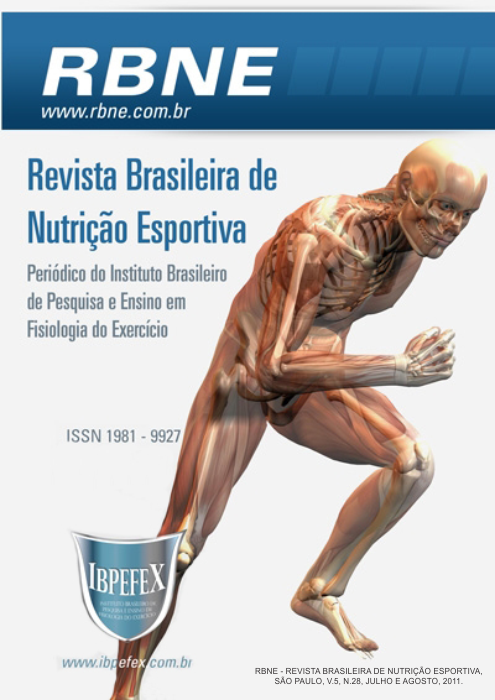Evaluation of anthropometric and nutritional profile of garbage collectors in training for half marathon
Abstract
The basis for achieving the minimum demand required, both energetic and nutritional, for the routine day to day work and of athe practice of sports is the realization of a balanced diet. In subjects with heavy work routines that also practice sports nutrition becomes even more important. The analysis of anthropometric profile enables a proper meal planning, thus impacting on the improvement of the performance in both of the activities. The study aimed to evaluate the anthropometric and nutritional profile of garbage collectors that were also training for a half marathon. We evaluated five street sweepers with average age, weight, height, BMI, of 30.8% G ±5.67 years, 68.6 ±13.40 kg, 1.73 ±0.11 m, 22.66 ±242 kg / m², 9.03 ±3.21% respectively. The averaged energy consumption were (EC) 2557.13 ±326.08 kcal and the average caloric intake for this group is 3872.47 ±756.56 kcal,in the macronutrients evaluation of the garbage collectors the consumption were of 5.75 g / kg and 60.36% of the EC-CHO, 1.6 g / kg and 17.08% for PTN, 0.96 g / kg and 22.55% of LIP, in accordance with the recommendations of the 2009 SBME guideline. It can be concluded that the energy consumption of this population is less than the daily necessities, but the intake of macronutrients and anthropometric profile of the recommendations are appropriate.
References
-Ainsworth, B.E,; Haskell, W.L.; Whitt, M.C.; e colaboradores.Compendium of Physical Activies: an Update of Activity Codes and MET intensities. Medicine & Science In Sports & Exercise. 2000.
-Anjos, L.A; Ferreira, J.A. Avaliação da Carga Fisiológica de Trabalho na Legislação Brasileira Deve Ser Revista! O Caso da Coleta de Lixo Domiciliar no Rio de Janeiro. Caderno de SaúdePública, Rio de Janeiro, Vol. 1. Num. 3. jul-set, 2000. p. 785-790.
-Cabral, C.A.C.; Rosado, G.P.; Silva, C.H.O.; Marins, J.C.B. Diagnóstico do EstadoNutricional dos Atletas da Equipe Olímpica Permanente de Levantamento de Peso do Comitê Olímpico Brasileiro (COB). Revista Brasileira de Medicina do Esporte. Vol. 12. Num. 6. nov-dez, 2006.
-Coelho, B.; Azeredo, C.; Bressan, E.; e colaboradores. Perfil Nutricional e Análise Comparativa dos Hábitos Alimentares e Estado Nutricional de Atletas Profissionais de Basquete, Karatê, Tênis de Mesa e Voleibol. Revista Brasileira de Nutrição Esportiva. Vol. 3. Num. 18. nov-dez, 2009. p. 570-577.
-Cuppari, L. Guia de Nutrição: Nutrição Clínica no Adulto. 2ª edição rev. e amp.. Barueri. Manole. 2005.
-Farinatti, P.T.V.; Apresentação de uma Versão em Português do Compêndio de Atividades Físicas: Uma Contribuição aos Pesquisadores e Profissionais em Fisiologia do Exercício. Revista Brasileira de Fisiologia do Exercício. Vol. 2. 2003. p. 177-208.
-Gomes, F.S.; Anjos, L.A.; Vasconcelos, M.T.L. Antropometria como ferramenta de avaliação do estado nutricional coletivo de adolescentes. Revista de Nutrição Campinas, Vol. 23 . Num. 4. jul-ago, 2010. p. 591-605.
-Jackson, A.S.; Pollock, M.L. Generalized Equations for Predicting Body Density of Men. British Journal of Nutrition. Vol. 40. 1978. p. 497-504.
-Marchioni, D.M.L.; Slater, B.; Fisisberg, R.M. Aplicação das dietary reference intakes na avaliação de nutrientes para indivíduos. Revista de Nutrição, Campinas, Vol. 17. Num. 2. abr-jun, 2004. p. 207-216.
-McArdle; W.D.; Katch, F.I.; Katch, V.L. Nutrição para o Esporte e o Exercício. 3ª edição. RJ. Guanabara Koogan. 2011.
-Nicastro, H.; Dattilo, M.; Santos, T.R.; Padilha, H.V.G.; Zimberg, I.Z.; Crispim, C.A.; Stulbach, T.E. Aplicação da escala de conhecimento Nutricional em atletas profissionais e amadores de atletismo. Revista Brasileira de Medicina do Esporte, Vol. 14, Num. 3. mai-jun, 2008.
-Panza, V.P.; Coelho, M.S.P.H.; Pietro, P.F.; Assis, M.A.A.; Vasconcelos, F.A.G. Consumo alimentar de atletas: reflexões sobre recomendações nutricionais, hábitos alimentares e métodos para avaliação do gasto e consumo energéticos. Revista de Nutrição, Vol. 20. Num. 6. nov-dec 2007.
-Pereira, J.M.O.; Cabral, P.; Avaliação dos Conhecimentos Básicos Sobre Nutrição de Praticantes de Musculação em Uma Academia da Cidade de Recife. Revista Brasileira de Nutrição Esportiva. São Paulo. Vol. 1. Num. 1. jan-fev, 2007. p. 40-47.
-Pontes, L.M.; Sena, J.E.A.; Ferreira, U.M.G. Perfil Antropométrico e da Composição corporal de garis de ambos os sexos que trabalham em setores diferenciados. Revista Digital Buenos Aires. Vol. 13. Num. 120. 2008.
-Rezende, F.A.C.; Rosado, L.E.F.P.L.; Priores, S.E.; Franceschini, S.C.Cl. Aplicabilidade de equações na avaliação da composição corporal da população brasileira. Revista de Nutrição. Campinas, Vol. 19. Num. 3. mai-jun, 2006. p. 357-367.
-Ribeiro, K.S.; Rosa, L.G.; Borges, L.R.L.; Paixão, M.P.C.P. Perfil Alimentar de Atletas Adolescentes Nadadores. Revista Brasileira de Nutrição Esportiva. São Paulo. Vol. 3. Num. 16. jul-ago, 2009. p. 331-339.
-Rogero, M.M.; Mendes, R.R.; Tirapegui, J.; Aspectos Neuroendócrinos e Nutricionais em Altetas com Overtraning. Arquivo Brasileiro de Endocrionologia e Metabolismo. Vol. 49. Num. 3. jun, 2005.
-Sociedade Brasileira de Medicina do Esporte (SBME). Modificações Dietéticas, Reposição Hídrica, Suplementos Alimentares e Drogas: Comprovação de Ação Ergogênica e Potenciais Riscos para a Saúde. Revista Brasileira de Medicina do Esporte. Vol. 15. Num. 3. mar-abr, 2009.
-Streicher, I.; Sousa, M.V. Avaliação da Ingestão Alimentar e Perfil Antropométrico de Corredores Recreativos. Revista Mineira de Educação Física. Vol. 13. Num. 1. 2005. p. 220-259.
Authors who publish in this journal agree to the following terms:
- Authors retain the copyright and grant the journal the right of first publication, with work simultaneously licensed under the Creative Commons Attribution License BY-NC which allows the sharing of the work with acknowledgment of the authorship of the work and initial publication in this journal.
- Authors are authorized to enter into additional contracts separately for non-exclusive distribution of the version of the work published in this journal (eg, publishing in institutional repository or book chapter), with acknowledgment of authorship and initial publication in this journal.
- Authors are allowed and encouraged to post and distribute their work online (eg, in institutional repositories or on their personal page) at any point before or during the editorial process, as this can bring about productive change as well as increase impact and impact. citation of published work (See The Effect of Free Access).






